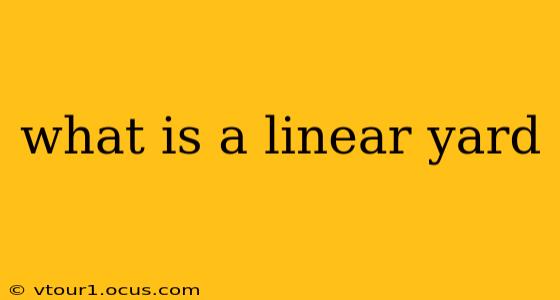A linear yard is simply a measurement of length equal to 3 feet or 36 inches. The term "linear" emphasizes that we're measuring in a straight line, as opposed to area (square yards) or volume (cubic yards). It's a fundamental unit of length in the imperial and US customary systems of measurement. Understanding linear yards is crucial in various applications, from construction and landscaping to fabric purchases and sports fields.
What is the Difference Between a Linear Yard and a Square Yard?
This is a common point of confusion. The key difference lies in the dimensionality of the measurement:
- Linear yard: Measures a single dimension – length. Think of it as the distance from point A to point B in a straight line.
- Square yard: Measures two dimensions – length and width. It represents the area of a square or rectangle with sides measuring one yard each. To calculate square yards, you multiply the length (in yards) by the width (in yards).
Imagine you're buying fabric. You need a linear yard to determine the length of the fabric you require. However, if you need to cover a specific area, such as a floor, you'd use square yards.
How Many Linear Feet are in a Linear Yard?
Since one yard equals three feet, there are three linear feet in one linear yard. This simple conversion is essential for various calculations and conversions between imperial units.
How Many Linear Inches are in a Linear Yard?
One yard equals 36 inches, meaning there are 36 linear inches in one linear yard. This conversion is helpful when dealing with smaller measurements or more precise calculations.
How is a Linear Yard Used in Different Industries?
Linear yards find application in diverse fields:
- Construction: Measuring the length of materials like lumber, pipes, or fencing.
- Landscaping: Determining the length of pathways, borders, or the perimeter of a garden.
- Textiles: Calculating the length of fabric, yarn, or other textile materials.
- Sports: Marking the length of a running track or the boundaries of a playing field.
What are Some Real-World Examples of Linear Yard Usage?
- A tailor needs 2 linear yards of fabric to sew a dress.
- A contractor needs 10 linear yards of fencing to enclose a garden.
- A runner completes a 100-yard dash (100 linear yards).
Understanding linear yards is essential for accurate measurements and calculations across a wide spectrum of tasks. Remembering the basic conversions (1 yard = 3 feet = 36 inches) is key to mastering linear yard measurements.
